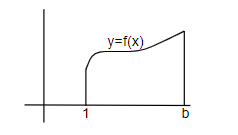Question
Question: If the area bounded by the x-axis, curve y = f (x) and the lines x = 1, x = b is equal to \( \sqrt{{...
If the area bounded by the x-axis, curve y = f (x) and the lines x = 1, x = b is equal to b2+1−2 for all b > 1, then f (x) is
a. x−1
b. x+1
c. x2+1
d. 1+x2x
Solution
Hint : We will first find the value of f (x) by generalizing the given relation, 1∫bf(x)dx=b2+1−2 and then we will differentiate the obtained general term to get the value of f (x).
Complete step-by-step answer :
It is given in the question that the area bounded by the x-axis, curve y = f (x) and the lines x = 1, x = b is equal to b2+1−2 for all b > 1 and we have been asked to find the value of f (x).
We can represent the given data as follows.

We know that the area under the curve y = (x) and x-axis is given by the integration of y = f (x) from 1 to b, as we have the lines x = 1 and x = b. So, we get,
Area = 1∫bf(x)
Now, we have been given that 1∫bf(x)dx is equal to b2+1−2 , so we can write,
1∫bf(x)dx=b2+1−2
We can also write 2 as 1+1 . So, we get,
1∫bf(x)dx=b2+1−1+1
Now, if we observe b2+1−1+1 , we get to know that we can generalize it using the general function [x2+1]1b , so we get,
1∫bf(x)dx=[x2+1]1b
We know that integration is the reverse of differentiation, so we can write it as,
f(x)=dxd(x2+1)
Now, we will differentiate (x2+1) with respect to x. We know that the derivative of x is 2x1 . So, we can write the derivative of (x2+1) as,
f(x)=2x2+11×2xf(x)=x2+1x
So, the correct answer is “Option D”.
Note : Many time, the students take the opposite limit after generalizing the function, f (x), they may take the function, ∫f(x)dx=[x2+1]b1 which gives the opposite result. They might get a negative sign in the area of the region found out, but it is also correct as we will neglect the negative sign because the area cannot be negative.
